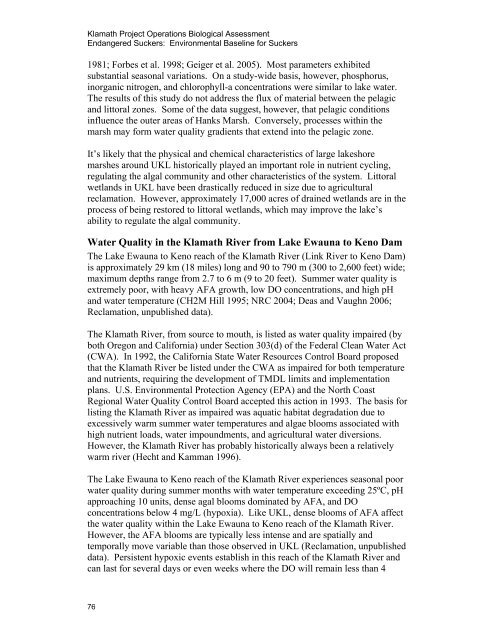Our new Biological Assessment is out - Klamath Basin Crisis
Our new Biological Assessment is out - Klamath Basin Crisis
Our new Biological Assessment is out - Klamath Basin Crisis
You also want an ePaper? Increase the reach of your titles
YUMPU automatically turns print PDFs into web optimized ePapers that Google loves.
<strong>Klamath</strong> Project Operations <strong>Biological</strong> <strong>Assessment</strong><br />
Endangered Suckers: Environmental Baseline for Suckers<br />
1981; Forbes et al. 1998; Geiger et al. 2005). Most parameters exhibited<br />
substantial seasonal variations. On a study-wide bas<strong>is</strong>, however, phosphorus,<br />
inorganic nitrogen, and chlorophyll-a concentrations were similar to lake water.<br />
The results of th<strong>is</strong> study do not address the flux of material between the pelagic<br />
and littoral zones. Some of the data suggest, however, that pelagic conditions<br />
influence the <strong>out</strong>er areas of Hanks Marsh. Conversely, processes within the<br />
marsh may form water quality gradients that extend into the pelagic zone.<br />
It’s likely that the physical and chemical character<strong>is</strong>tics of large lakeshore<br />
marshes around UKL h<strong>is</strong>torically played an important role in nutrient cycling,<br />
regulating the algal community and other character<strong>is</strong>tics of the system. Littoral<br />
wetlands in UKL have been drastically reduced in size due to agricultural<br />
reclamation. However, approximately 17,000 acres of drained wetlands are in the<br />
process of being restored to littoral wetlands, which may improve the lake’s<br />
ability to regulate the algal community.<br />
Water Quality in the <strong>Klamath</strong> River from Lake Ewauna to Keno Dam<br />
The Lake Ewauna to Keno reach of the <strong>Klamath</strong> River (Link River to Keno Dam)<br />
<strong>is</strong> approximately 29 km (18 miles) long and 90 to 790 m (300 to 2,600 feet) wide;<br />
maximum depths range from 2.7 to 6 m (9 to 20 feet). Summer water quality <strong>is</strong><br />
extremely poor, with heavy AFA growth, low DO concentrations, and high pH<br />
and water temperature (CH2M Hill 1995; NRC 2004; Deas and Vaughn 2006;<br />
Reclamation, unpubl<strong>is</strong>hed data).<br />
The <strong>Klamath</strong> River, from source to m<strong>out</strong>h, <strong>is</strong> l<strong>is</strong>ted as water quality impaired (by<br />
both Oregon and California) under Section 303(d) of the Federal Clean Water Act<br />
(CWA). In 1992, the California State Water Resources Control Board proposed<br />
that the <strong>Klamath</strong> River be l<strong>is</strong>ted under the CWA as impaired for both temperature<br />
and nutrients, requiring the development of TMDL limits and implementation<br />
plans. U.S. Environmental Protection Agency (EPA) and the North Coast<br />
Regional Water Quality Control Board accepted th<strong>is</strong> action in 1993. The bas<strong>is</strong> for<br />
l<strong>is</strong>ting the <strong>Klamath</strong> River as impaired was aquatic habitat degradation due to<br />
excessively warm summer water temperatures and algae blooms associated with<br />
high nutrient loads, water impoundments, and agricultural water diversions.<br />
However, the <strong>Klamath</strong> River has probably h<strong>is</strong>torically always been a relatively<br />
warm river (Hecht and Kamman 1996).<br />
The Lake Ewauna to Keno reach of the <strong>Klamath</strong> River experiences seasonal poor<br />
water quality during summer months with water temperature exceeding 25ºC, pH<br />
approaching 10 units, dense agal blooms dominated by AFA, and DO<br />
concentrations below 4 mg/L (hypoxia). Like UKL, dense blooms of AFA affect<br />
the water quality within the Lake Ewauna to Keno reach of the <strong>Klamath</strong> River.<br />
However, the AFA blooms are typically less intense and are spatially and<br />
temporally move variable than those observed in UKL (Reclamation, unpubl<strong>is</strong>hed<br />
data). Pers<strong>is</strong>tent hypoxic events establ<strong>is</strong>h in th<strong>is</strong> reach of the <strong>Klamath</strong> River and<br />
can last for several days or even weeks where the DO will remain less than 4<br />
76










